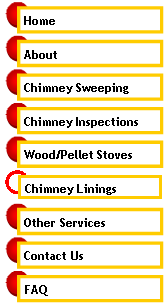|
When a chimney is built during the construction phase, the flues are normally built with clay tile liners. These clay tile liners should be joined together with refractory mortar so that the liner and the masonry joint will have the same expansion rate under hot and cold conditions, which will limit the appearance of cracks in the joints. Most chimneys built today with clay tile liners are not joined together with refractory mortar but are built with regular mortar which can cause the liner system to crack and sometimes even fall apart under stress. Expansion and contraction cracks of a flue tile is the most common type of damage seen in a chimney. Therefore, if you are having a new chimney added to your home, insist that the mason use refractory mortar for your clay tile liner.
When an existing chimney needs to be relined, we start by looking at the type of appliance that is to be vented into the flue. There are several ways to reline a chimney. A stainless steel liner is the most common way. There are different grades and thicknesses of stainless steel, and the type of appliance that is being used determines which grade and thickness of stainless steel should be installed. We also use a product called HeatShield® for the relining of some chimneys.
Wood Stoves: When relining a chimney for a wood stove, the wood stove manufacturer normally states that the liner for the wood stove must be installed to meet the NFPA-211 standards or the IRC standards (whichever had jurisdiction). Most chimney liner manufacturers require insulation around the liner in order to meet the NFPA-211 or IRC code requirements. There are some occasions where the clay flue tiles have to be removed in order to install a new lining system. When relining a chimney for a wood stove, we recommend using a 304-alloy stainless steel liner. We recommend either a heavy flex or a hybrid flex liner for wood stoves because they are thicker and can be cleaned using a wire brush system. Wood stoves typically generate creosote build-up, which is best cleaned by a metal brush. Light flex liners can be used for wood stoves; however, they can only be cleaned by using a poly brush (using a metal brush in a light flex liner will potentially void the liner warranty and may even damage the liner).
Oil Furnaces/Burners/Hot Water Heaters: When relining for an oil appliance, we recommend using a 316-alloy light flex liner. The 316-alloy is a particular type of stainless steel that is manufactured to not break down from the corrosiveness of the oil soot and any condensation that may occur in the pipe (oil soot and water/condensation together make a low-grade sulfuric acid). With the newer higher efficiency units out on the market today, we believe it is a good idea to insulate the liner because it helps maintain efficiency of the unit by keeping the flue stack temperature at a more consistent level. However, insulating the liner is currently not mandatory according to the building codes or the liner manufacturers.
Gas Hot Water Heater/Furnace/Burner, or a Gas Fireplace/Stove: When relining for a gas appliance, the type of gas appliance involved is very important to consider, as they fall into four distinct categories. Each category has itsown specifications for either lining or venting. Most of the home heating appliance for gas fall under Category 1 and require a 316-alloy stainless steel liner. When relining for a gas appliance, the recommendations of the gas appliance manufacturer and the NFPA-54 National Flue and Gas code must be followed.
Fireplaces: When relining for a wood-burning fireplace, most of the time the clay flue tiles will need to be removed so that a stainless liner can be properly installed. This is not something we take lightly. Extra care must be taken when removing the clay flue tiles so that the chimney structure itself is not damaged and any adjoining flues are not damaged as well. It is very important to size a fireplace properly so that it will draft properly. The liner must also be insulated in order to meet the liner manufacturer’s specifications as well as the NFPA-211 code. When the fireplace liner is installed, it is important to cement the liner end into the smoke chamber to ensure a smooth transition for the flue gases.
In some instances a fireplace can be relined by using a product called HeatShield®. HeatShield® is a specifically formulated “Cerfractory®” sealant material that restores the integrity of the chimney’s flue for the proper venting of flue gases.
Pellet Stoves: When relining an existing chimney for a pellet stove, we recommend insulating the liner for peak performance for the stove, although it is not required by the manufacturer. We typically use a light 316-alloy flex pipe liner for pellet stoves and insulate the liner all the way up to the top of the chimney.
|


